Tibet is located on the plateau, and the natural environment has a profound influence on the Tibetan people's staple food. For thousands of years, they have relied on the rich local resources to create unique and delicious staples.
This article will take you through the highland's produce and how Tibetans ingeniously utilize the barren land to craft nutritious staples. For tourists heading to Tibet, sampling the local staples will be an excellent way to immerse yourself in the plateau environment and experience Tibetan culture.
All Tibetan Staple Food is Derived from Natural Products
The snow-capped mountains of Tibet provide abundant and pure glacier meltwater resources. The meadows offer rich grazing for yaks and sheep, along with ample breeding grounds. The dry climate and abundant sunlight provide high-quality starch and sugar content for the plants on the plateau. In short, "all-natural" is the perfect way to describe Tibetan crops.
In the highlands of Tibet, barley is cultivated, which belongs to the barley family. Like wheat and oats, barley is rich in protein, carbohydrates, dietary fiber, and various vitamins. Barley grains are coarser than wheat, which helps promote digestion in the cold high-altitude environment. Due to the ample and intense sunlight in the highlands, barley has a higher sugar content and a sweeter taste.
 Local Tibetans are harvesting highland barley.
Local Tibetans are harvesting highland barley.Potatoes grown in the Tibetan plateau differ from those in other regions. Tibetan potatoes have a high yield, large size, thin skin, a fragrant and sweet taste, and a slightly sticky texture. Due to the long daylight hours and significant temperature fluctuations in the highlands, Tibetan potatoes have a high starch content, making them exceptionally tasty and sweet. Tibetans often fry, roast, deep-fry, or steam potatoes, which are as important to them as bread.
The eastern regions of Nyingchi and Bome in Tibet are densely forested, yielding a variety of forest products such as mushrooms and medicinal herbs. Some particularly famous ones include matsutake mushrooms, gastrodia elata, and wood ear mushrooms. Moreover, the forests also provide byproducts like honey collected from the forest and forest shrubs consumed by Tibetan fragrant pigs raised in the area.
Yaks and sheep are typical animals in the grasslands of the Tibetan plateau. Tibetan yaks and their dairy products provide the Tibetan people with high-quality protein, and all livestock feed on natural grasslands.
What are the Popular Tibetan Staple Foods?
Explore the world of Tibetan cuisine, savoring a variety of staples and distinctive culinary techniques. From fragrant and tender potatoes to nutritious yak meat; from boiling, stewing, and frying to creative dumpling making, each dish showcases the Tibetan people's culinary wisdom and passion for food.
1) Tibetan Potatoes
Tibetan Potatoes are beloved by the Tibetan people for their sweet, fragrant, and tender qualities. The simplest method to prepare them is by placing the potatoes in a pressure cooker, adding an appropriate amount of salt and seasonings, and cooking them until they become deliciously sweet and flavorful.
Another popular method is to stew the potatoes together with beef. The firm texture of the beef complements the softness of the potatoes, creating the perfect culinary pairing.
One of the most beloved preparations involves frying the potatoes. They are sliced into pieces or long strips, deep-fried until they turn golden and crispy on the outside, and then seasoned with some chili powder. This dish is among the most popular street snacks in Lhasa.
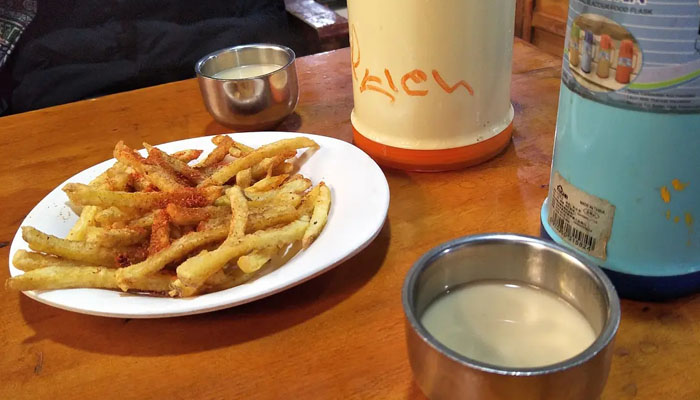 Tibetan fried potatoes served in Lhasa’s restaurant
Tibetan fried potatoes served in Lhasa’s restaurantA creative approach involves turning potatoes into potato starch, which is cooked, cooled, and served in a jelly-like form with seasonings and chili oil, creating a refreshing and tasty cold dish.
There's also an unusual method where potatoes are used to make potato dumplings. Potato mash is used as the dumpling skin to wrap yak meat, and the dumplings are then deep-fried to make the potatoes crispy and delicious, offering a unique culinary experience.
2) Barley
Barley is an essential staple in the daily diet of the Tibetan people. Barley is harvested only once a year and can be stored for extended periods after drying. Similar to popcorn, high-temperature roasting of barley can turn it into roasted barley, which serves as a common snack in daily life.
When mature barley is ground into powder, it can be used to make barley Tsampa, barley pastries, and even turned into barley porridge, which is a primary supplementary food for babies after weaning. Barley is also a crucial ingredient in brewing. Fermentation using barley yeast can produce sweet barley wine and even beer.
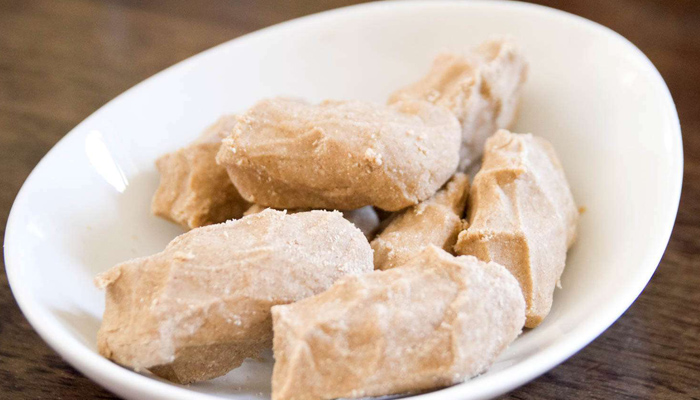 Barley is often used to make Tsampa.
Barley is often used to make Tsampa.3) Yak Meat and Yak Milk
Yak meat is widely used in Tibetan cuisine and can be prepared in various ways, including grilled yak steak, stewed yak meat, hand-grabbed yak meat, pan-fried yak steak, blood sausages, yak meat dumplings, air-dried yak meat, and beef jerky, among at least a dozen different preparations. Yak meat's versatility allows it to cater to various taste preferences.
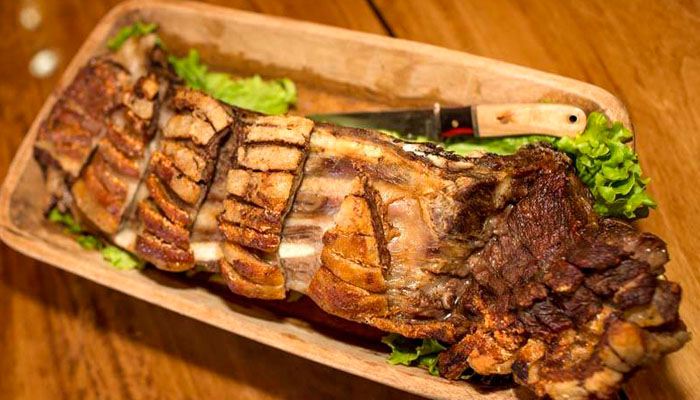 Tibetan grilled yak steak is a delicious dish in Tibet.
Tibetan grilled yak steak is a delicious dish in Tibet.Dairy products from yaks are also essential in Tibetan cuisine. Fresh yak milk, yogurt, milk residue, cheese, butter tea, and sweet tea are all fundamental products made from yak and sheep milk. In Tibetan plateau, yak and sheep are the primary sources of both meat and dairy protein.
4) Nyingchi Matsutake Mushrooms and Tibetan Pigs
The dense forests of the Nyingchi region are home to a rich variety of edible mushrooms, including one of China's most delicious edible mushrooms - matsutake. Matsutake mushrooms are renowned for their unique aroma and exquisite taste, making them a sought-after ingredient in various cuisines.
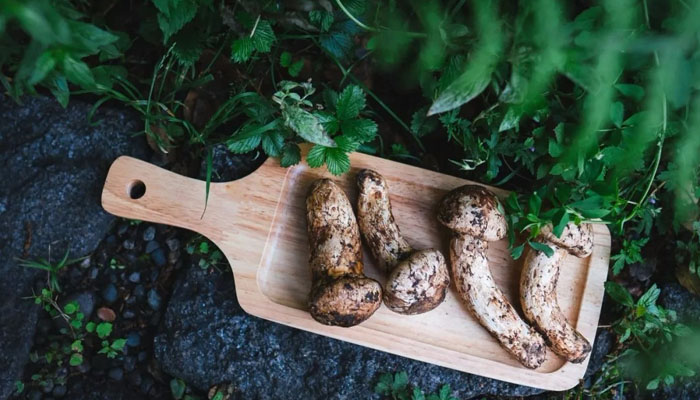 Nyingchi Matsutake mushrooms are sought-after ingredient in various cuisines.
Nyingchi Matsutake mushrooms are sought-after ingredient in various cuisines.They have a firm white stem and a yellow-brown cap, typically appearing in the autumn. Nyingchi's matsutake mushrooms are highly prized locally and attract food enthusiasts and gourmets every year to experience their unique flavor.
Nyingchi is also famous for Tibetan pig meat. Tibetan pigs grow slowly and are raised in the forest from a young age, grazing on a variety of herbs and plants. As a result, their meat has a delicate texture and lower fat content, making it a highly nutritious source of meat. Locals often use Tibetan pig meat to make preserved pork or slow-cook it over charcoal, creating a rich yet not greasy roasted pork with a distinctive flavor.
What Types of Tibetan Staple Dishes Should Tourists Try?
What makes Tibetan cuisine unique is its ability to create the most delicious and nutritionally rich food from the simplest ingredients. Tibetan cuisine often relies on minimal seasonings, with simple salt bringing out the authentic flavors.
When visiting Tibet, it's best to try the local staples, as this is the ideal way to adapt to the high-altitude environment and acclimate to the changes. Here are several popular Tibetan staple dishes that you can find in restaurants throughout Tibet:
1) Tibetan Noodles - Served with Sha Bale, 12 RMB per person
Tibetan noodles, known as "Tibetan Thukpa," are a signature dish in Tibetan restaurants that almost everyone traveling to Tibet tries. The noodles for Tibetan Thukpa are prepared in advance, cooked, and then air-dried for later use. When you're ready to enjoy them, the noodles are reheated in a pot of yak meat soup and served steaming hot.
 Tibetan noodles are a signature dish in Tibetan restaurants.
Tibetan noodles are a signature dish in Tibetan restaurants.The cooked Tibetan noodles are ladled into a bowl, topped with delicious yak meat, and accompanied by a small dish of pickled radishes. On the table, you'll also find Tibetan-style hot sauce that you can mix according to your personal taste, completing a highly flavorful bowl of Tibetan noodles.
Tibetan hot sauce differs from mainland Chinese hot sauce, as it is made by diluting it with water and incorporates Tibetan spices and salt, giving it a unique flavor profile. When you first taste Tibetan hot sauce, it doesn't initially seem spicy; instead, it's flavorful. However, after a few bites, the spiciness gradually kicks in.
Lhasa is known for having the most delicious Tibetan noodles, with dedicated shops selling Tibetan Thukpa and popular restaurants offering various Tibetan dishes, such as Anitsangkung Nunnery Tea House and Guangming Gangqiongtian Tea House. It's recommended to try Tibetan noodles in Lhasa, and if you find the taste to your liking, you can indulge in them multiple times as they are reasonably priced and filling.
Furthermore, the combination of Tibetan noodles served with Shapale is considered one of the most budget-friendly Tibetan meals, costing only 12 RMB and providing a delicious and satisfying dining experience. Whether at street-side stalls or certain restaurants in Tibet, you can easily find this classic combination, allowing you to taste authentic Tibetan cuisine at a reasonable price.
2) Yak Meat Tibetan Momo - Served with Sweet Tea, 20 RMB per person
When traveling to Tibet, not trying Yak Meat Tibetan momos is like visiting Chengdu or Chongqing without having a hotpot—an incomplete travel experience!
Yak Meat Tibetan Momo is one of the most filling and nutritious lunches you can have in Tibet. Each momo costs only 2 RMB and is filled with rich yak meat stuffing. Each bite bursts with flavorful juices, and the meat is savory and delicious. One serving of Yak Meat Momo typically includes 8-10 pieces, which is enough to satisfy the lunchtime hunger of an average adult. Drizzling some chili sauce over the Yak Meat Baozi adds even more flavor and variety to the taste.
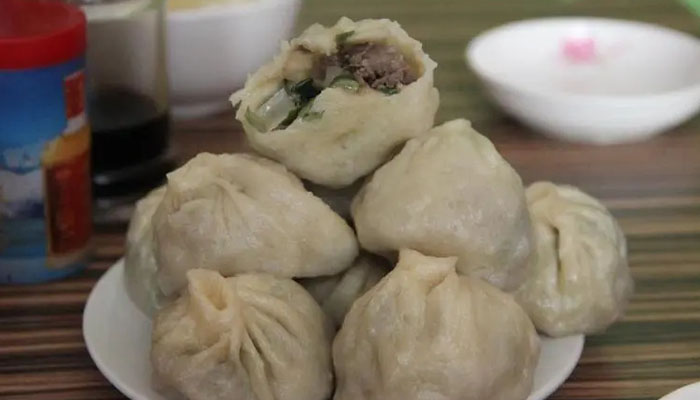 Yak meat Tibetan momo is one of the most filling and nutritious lunches to try in Tibet.
Yak meat Tibetan momo is one of the most filling and nutritious lunches to try in Tibet.The perfect accompaniment for yak meat momo is Tibetan sweet tea. Since Tibet barely produces vegetables (except in the eastern region of Nyingchi), tea, rich in various vitamins, becomes a staple in the locals' diet. Tibetan sweet tea is typically made using black or red tea. It's slowly brewed in boiling water, filtered, and then mixed with powdered milk, yak milk, and sugar, simmering until it becomes fragrant and delicious.
Sweet tea is usually sold in insulated thermoses, costing around 3 RMB for a 500ml bottle, suitable for two people, or 5 RMB for a 1-liter bottle, which serves about five people. Combining yak meat momos with sweet tea costs just around 20 RMB and offers a nutritious combination of meat, tea, and dairy.
3) Tsampa - Served with Butter Tea, 15 RMB per person
Tsampa is an essential staple and one of the distinctive delicacies of Tibet. It's actually roasted barley flour. When consumed, you can add a small amount of butter tea, milk residue, and sugar, and after mixing it thoroughly, shape it into small clumps with your hands for consumption.
For Tibetans, Tsampa is as vital a staple as rice noodles are in Yunnan or spicy noodles in Chongqing, making it an indispensable part of their daily diet. Moreover, Tsampa can also be carried as a snack. Nomads only need to bring Tsampa flour and mix it with milk from the area to form Tsampa cakes. When camping outdoors, enjoying Tsampa with butter tea is the most authentic combination.
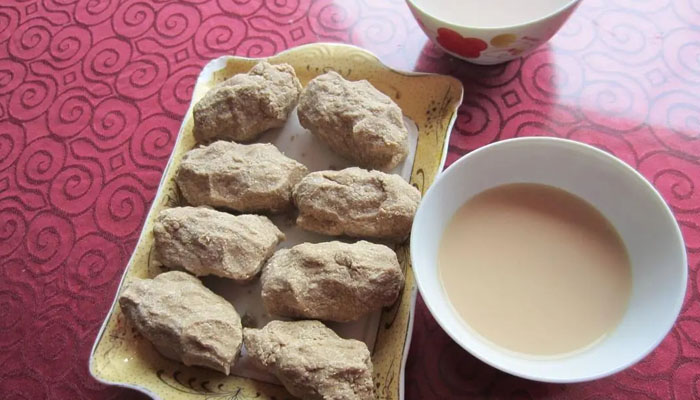 Enjoying Tsampa with butter tea is the most authentic combination.
Enjoying Tsampa with butter tea is the most authentic combination.When dining in a typical Tibetan restaurant, the owner may serve a bowl of Tsampa flour, a plate of sugar, a plate of milk residue, and a bowl of rich butter tea. Locals mix the ingredients according to their taste and shape them into small clumps to eat with their hands. For tourists unfamiliar with shaping Tsampa, you can ask the restaurant owner or a guide for assistance. While hand-shaped Tsampa may not be the most aesthetically pleasing, it is incredibly delicious, and the process of shaping and eating it is quite enjoyable.
This combination allows you to savor the taste of Tsampa while enjoying authentic butter tea, providing a unique flavor experience. It's reasonably priced, around 15 RMB per person, making it an ideal choice to try this traditional Tibetan staple in Tibetan restaurants.
4) Curry Potato Beef Rice, 25 RMB/Person
Curry Potato Beef Rice, also known as Potato Rice Bowl with Yak Meat, is priced at 25 RMB per person. This dish involves simmering potatoes and yak meat, then pouring the flavorful broth over rice, garnished with generous portions of yak meat and potatoes.
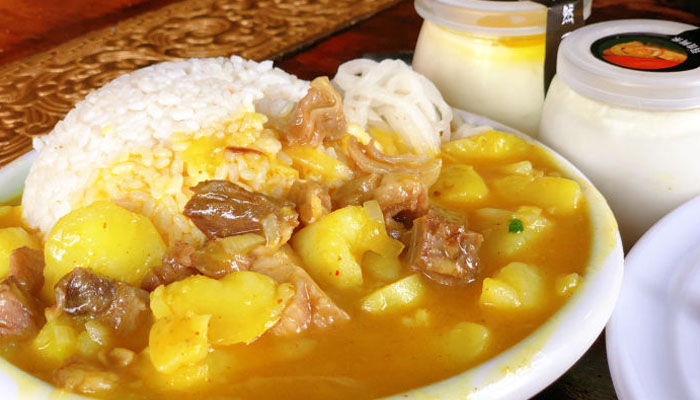 Tibetan curry potato beef rice is one of the most nutritionally rich options in Tibetan cuisine.
Tibetan curry potato beef rice is one of the most nutritionally rich options in Tibetan cuisine.It's a curry dish that caters to the tastes of most tourists. The preparation is straightforward, with restaurant chefs often having a large pot of yak meat and potato stew ready. When customers order, the stewed yak meat and potato broth can be directly poured over the rice, accompanied by a small dish of pickled radishes, requiring minimal waiting time.
Curry Potato Beef Rice combines two distinct Tibetan staples: nutrient-rich yak meat and the tender, fragrant highland potato, satisfying the body's need for proteins, carbohydrates, and essential nutrients. We recommend it as one of the most nutritionally rich options in Tibetan cuisine meal sets.
5) Tibetan Hot Pot, 80-120 RMB/Person
Hot pot is a popular dish with regional variations throughout China, and Tibetan hot pot offers a unique dining experience. Unlike conventional hot pots, Tibetan hot pot involves cooking various vegetable dishes and meat together in a single pot, creating a generous mountain of ingredients.
Typically, Tibetan hot pot includes four types of meat and four types of vegetables. Meat options often consist of yak meat, yak meat tongue, pork, and meatballs, while vegetable choices include carrots, radishes, Chinese cabbage, and wood ear mushrooms.
 Tibetan Hot pot includes various vegetable dishes and meat.
Tibetan Hot pot includes various vegetable dishes and meat. For the dipping sauce, many locals simply add a bit of broth to their bowl, usually requiring no additional seasoning. However, if desired, hot pot restaurants typically provide various condiments such as green onions, garlic, and cilantro. The broth base for Tibetan hot pot is usually prepared from yak bones, with a clear, slightly milky appearance and a relatively mild flavor.
You can find numerous Tibetan hot pot restaurants on the streets of Lhasa, each with its unique flavors. You can opt for larger restaurants with more customers, seek recommendations from locals, or even ask your tour guide for suggestions.
6) Lulang Stone Pot Chicken, 60-100 RMB/Person
Lulang Stone Pot Chicken is a specialty cuisine from the southeastern region of Tibet in Nyingchi. The primary ingredients for this delicacy include locally sourced chicken and precious mushrooms like matsutake. The preparation of Stone Pot Chicken owes much to the unique stone pots made from minerals found in the Motuo area along the Tibetan border. This delicious dish is rich in Tibetan flavors and is a must-try during your trip to Tibet.
 Nyingchi Lulang Stone Pot Chicken is suitable for people of all ages.
Nyingchi Lulang Stone Pot Chicken is suitable for people of all ages.The taste of Lulang Stone Pot Chicken is mild, and it involves placing the ingredients in the stone pot and cooking them, similar to a hot pot, making it suitable for people of all ages. You can primarily find this dish in the city of Nyingchi, and along the 318 National Highway from Ranwu to Lhasa, wherever there are restaurants catering to tourists, there will likely be one specializing in Stone Pot Chicken.
For an authentic experience, it's best to visit during the spring and summer seasons when the rainy weather is conducive to the growth of mushrooms, ensuring fresher ingredients.
Conclusion
The Tibetan dishes are based on the simplest and most traditional staple foods of the plateau, making them easy to prepare and quick to serve, while also being nutritionally rich and filled with the flavors of the Tibetan plateau. You can enjoy them in ordinary Tibetan restaurants. Even with a limited travel budget, following our recommendations, you can savor delicious and nutritious meals for as little as 50 RMB per day.
Of course, Tibet also offers more exquisite and intricately prepared Tibetan cuisine, which is an integral part of the culinary journey in Tibet. If your budget allows, consider trying some of the finer Tibetan dishes to experience a broader range of flavors and culinary techniques. Tibetan cuisine is incredibly diverse, whether it's simple and traditional or refined and complex, it's all worth a try.
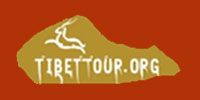



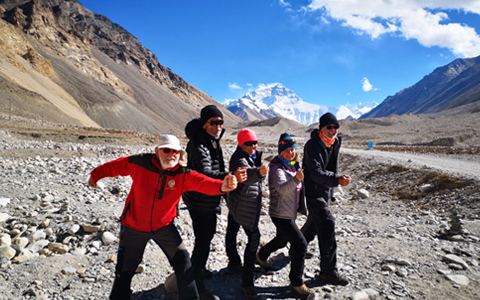
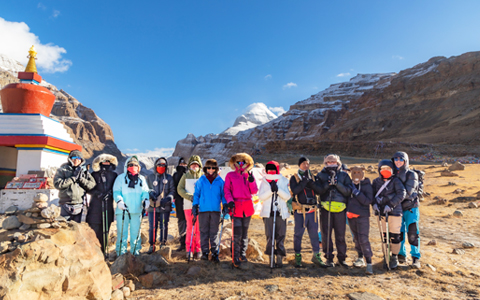



















 Local Tibetans are harvesting highland barley.
Local Tibetans are harvesting highland barley.
 Tibetan fried potatoes served in Lhasa’s restaurant
Tibetan fried potatoes served in Lhasa’s restaurant Barley is often used to make Tsampa.
Barley is often used to make Tsampa. Tibetan grilled yak steak is a delicious dish in Tibet.
Tibetan grilled yak steak is a delicious dish in Tibet. Nyingchi Matsutake mushrooms are sought-after ingredient in various cuisines.
Nyingchi Matsutake mushrooms are sought-after ingredient in various cuisines. Tibetan noodles are a signature dish in Tibetan restaurants.
Tibetan noodles are a signature dish in Tibetan restaurants.
 Yak meat Tibetan momo is one of the most filling and nutritious lunches to try in Tibet.
Yak meat Tibetan momo is one of the most filling and nutritious lunches to try in Tibet. Enjoying Tsampa with butter tea is the most authentic combination.
Enjoying Tsampa with butter tea is the most authentic combination. Tibetan curry potato beef rice is one of the most nutritionally rich options in Tibetan cuisine.
Tibetan curry potato beef rice is one of the most nutritionally rich options in Tibetan cuisine. Tibetan Hot pot includes various vegetable dishes and meat.
Tibetan Hot pot includes various vegetable dishes and meat.  Nyingchi Lulang Stone Pot Chicken is suitable for people of all ages.
Nyingchi Lulang Stone Pot Chicken is suitable for people of all ages.







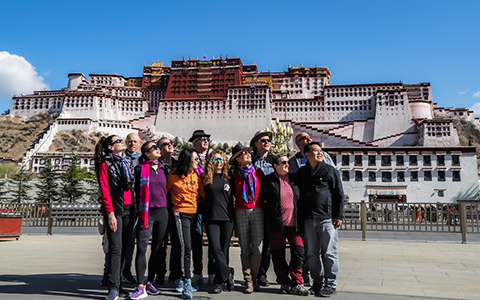

Ask a Quick Question